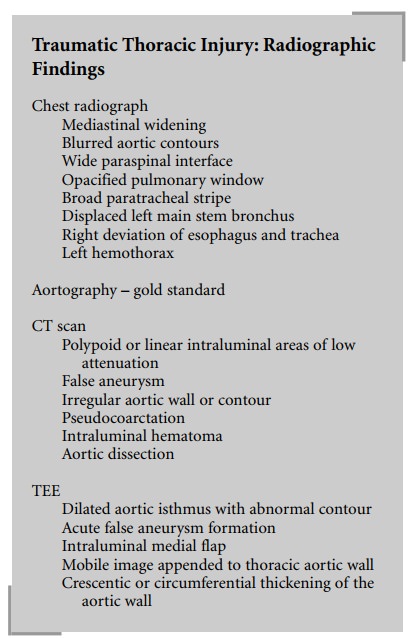Chapter: Clinical Cases in Anesthesia : Thoracic Trauma
In blunt trauma patients with multiple injuries that include thoracic aortic injury, how is surgery prioritized?
In blunt
trauma patients with multiple injuries that include thoracic aortic injury, how
is surgery prioritized?
A patient with an injury that involves complete
or a nearly complete circumferential transection of all three layers of the
aortic wall is unlikely to arrive in the operating room. Those who make it to
the surgery with this pathology generally have either a small perforation or a
partial transection that is temporarily sealed with perivascular clot formation
or a relatively large transection that bleeds at a relatively slow rate because
of hypotension and possibly perivascular barriers such as adjacent tissues or
clot covering the lesion. In our experience, patients who have up to 70%
transection of the aortic circumference can survive until surgery. Most
patients who arrive in the operating room have relatively small sealed subadventitial
posterior wall injuries, which require surgical repair because of impending
rupture. In addition, there are a significant number of patients who have
intimal and/or medial layer injury, which can be managed conservatively or
surgically, if necessary, on an elective basis. Undoubtedly, tho-racic aortic
injury represents a true surgical emergency but not all types of traumatic
lesions carry the same degree of urgency. Thus, in hemodynamically stable
patients with no intracranial pathology, assessment of the type of vascular
injury with contrast-enhanced spiral CT provides important information for
surgical prioritization.
Another important factor is the type and extent
of associ-ated injuries. Traumatic intracranial lesions and gross bleed-ing into
body cavities are more emergent than stable aortic injuries seen on CT scan. In
most instances, hypotension in these patients is caused by the associated
injuries rather than the aortic injury itself, and at times these patients may
have to be rushed to the operating room without any radiologic investigation.
As mentioned, TEE in those circumstances helps immensely to determine the
extent of aortic injury intraoperatively while the other injuries are being
managed.
In summary, actively bleeding aortic injuries
with hemodynamic instability have the highest surgical priority. If they occur
concomitantly with unstable abdominal injuries or head injury, which is a
relatively rare event, simultaneous intervention should be considered. In the
absence of an unstable associated injury, the aortic injury should be repaired
as early as possible.

Surgical repair of the thoracic aorta requires
clamping of the vessel. In the presence of intracranial pathology this maneuver
may result in an uncontrollable rise in intracranial pressure. Thus, a
significant intracranial hematoma must be evacuated with at least a burr hole.
For small intracranial traumatic lesions, monitoring of the intracranial
pressure during the aortic repair may suffice.
Related Topics